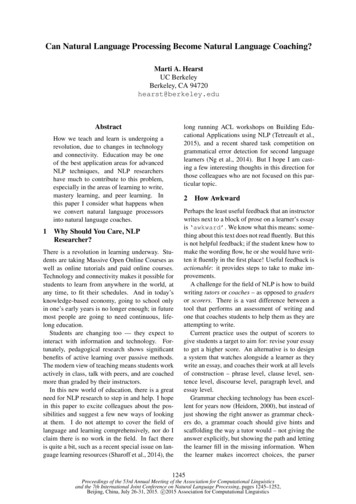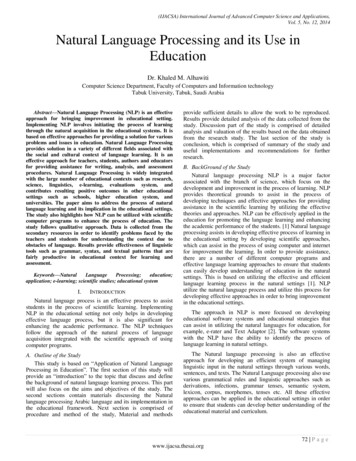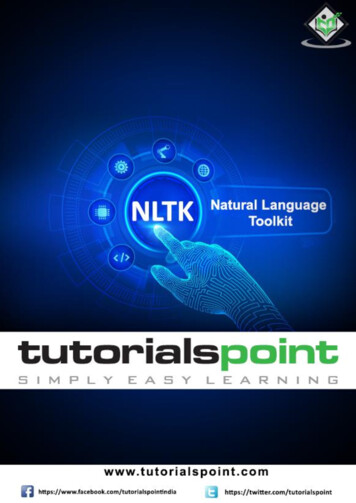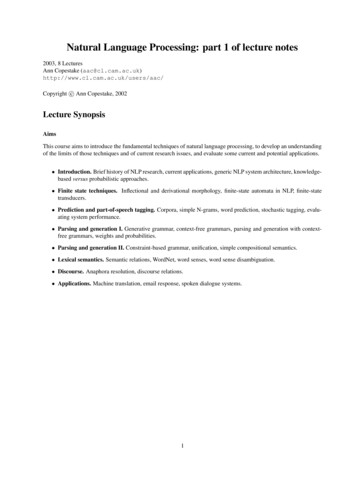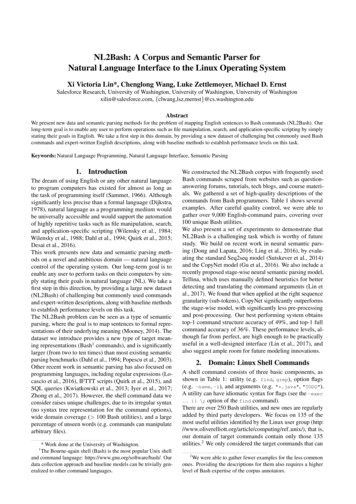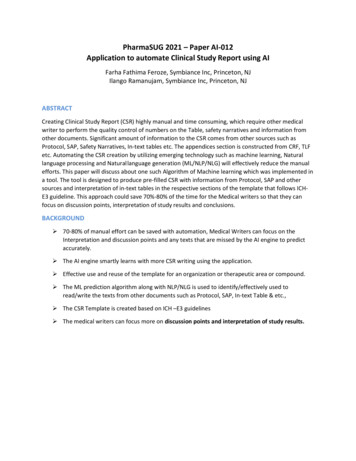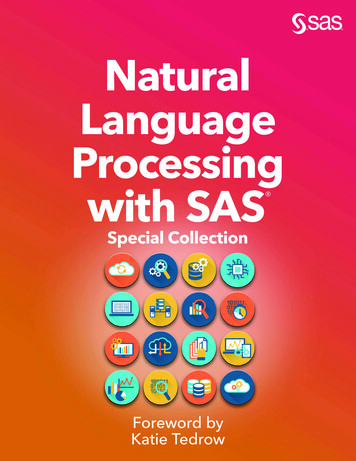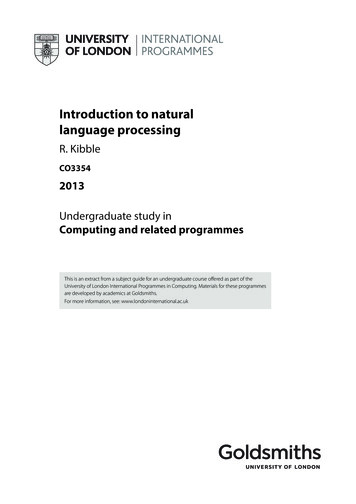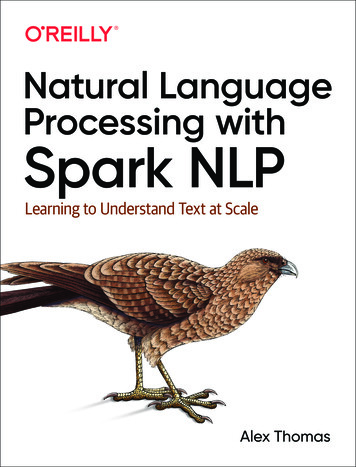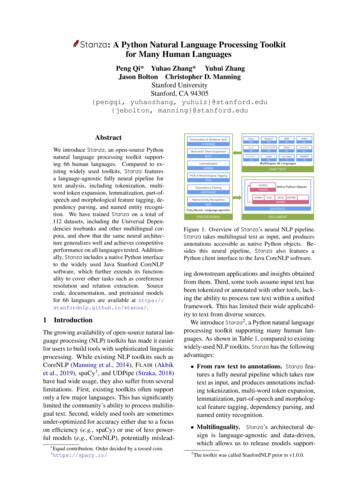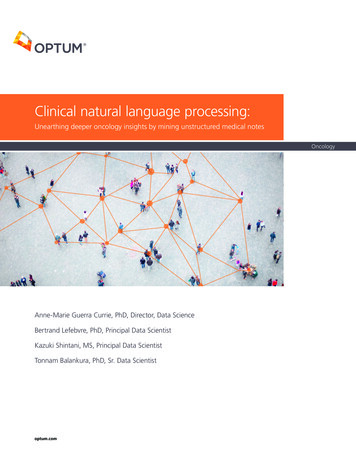
Transcription
Clinical natural language processing:Unearthing deeper oncology insights by mining unstructured medical notesOncologyAnne-Marie Guerra Currie, PhD, Director, Data ScienceBertrand Lefebvre, PhD, Principal Data ScientistKazuki Shintani, MS, Principal Data ScientistTonnam Balankura, PhD, Sr. Data Scientistoptum.com
Clinical natural language processing: Unearthing deeper oncology insights by mining unstructured medical notesOptum oncology data initiatives include enrichingour data by extracting essential information from theoncology patient’s medical records and making it usablefor researchers. Specific oncology concepts important inunderstanding the progression of the disease are oftennot available in structured formats, particularly the tumor,node and metastasis (TNM) values, stage information andbiomarkers.2Mpatients who have at leastone solid tumor ICD codeWe surface this critical and detailed oncology data by leveraging our proprietary natural language processing(NLP) system that performs automated information extraction on the free-text medical records repositorywithin the Optum electronic health record (EHR) data asset to provide key oncology-related insights to ourclients in an easy-to-use format.Our oncology-focused NLP system is designed to identify the positive occurrences of desired oncologyconcepts, such as cancer type, TNM, stage and biomarkers, as well as enable the exclusion of semanticcontexts that are not desired oncology contexts.For example, if the goal is to identify patients with prostate cancer, the Optum NLP system identifies differentsemantic contexts and appropriately extracts the desired contexts into a structured format. The concepts arethen able to be easily searched by our clients. Some examples of the contexts that occur within the notes areshown in Table 1:Table 1. Sample of contexts for cancer statementsSample textConcept“Patient has stage II prostate cancer”Patient positive for prostate cancer“Negative for prostate cancer”Patient negative for prostate cancer“ If prostate cancer is found, patient may requireadditional imaging”Hypothetical prostate cancer situation“Might be prostate cancer”Hedged prostate cancer statement“ Prostate cancer is a common cancer among males”Prostate cancer not relevant to patientWithin the Optum EHR data source, there are 2 million patients who have at least one solid tumor ICD code.Manually reviewing hundreds of millions of documents, and manually extracting clinical data for research,is not a scalable approach. Our NLP system offers an automated solution for providing insights from a largecollection of medical notes that continues to grow each day.optum.comPage 2
Clinical natural language processing: Unearthing deeper oncology insights by mining unstructured medical notesInformation extraction process: Entities, relations and framesAs the NLP system processes the clinical notes data, our trained models extract relevant entities in thetext and the relationships between them using three approaches:123Entity extractionThe extraction of a concept or entity represented by lexical units or phrases in the free text.Relation extractionThe extraction of the relationships between entities.Frame extractionThe extraction of the logical semantic group of lexical units and the collection of any relevant relations.Example A shows the entity, relations and frame extraction. Individual entities are tagged, or labeled andlinked to one another via relations. Relation extraction links one tag to another tag.In Example A, “cancer” tag links to “direction” and “stage tnm” tags. Frame extraction groups relationsoriginating from the same parent concept into a structure that is more easily consumable as table-like data.The frame is a logical set of semantic units, and the frame for the cancer stage context is shown extracted intotable format in Example A.Example A. Entity, relation, frame tagging and extractionSentence: “Left breast cancer stage T1b N1mi M0.”Entity tagging:directioncancerLeftbreaststage tnmcancer stageT1b N1mi M0Relation linking:directionLefthas directioncancerbreasthas stagecancer stagestage tnmT1b N1mi M0Entity, relation, frame extraction:FrameCancerDirectionStage tnmcancerbreastleftT1b N1mi M0optum.comPage 3
Clinical natural language processing: Unearthing deeper oncology insights by mining unstructured medical notesModeling approachThe Optum oncology NLP system leverages best practices in data science and automation. Our sophisticatedsystem goes beyond term-matching and rules-based approaches by incorporating machine learning and deeplearning, in order to ensure the correct identification of the desired oncology context.The advantage of leveraging supervised machine learning models is the ability to accurately identify theappropriate contexts in an automated fashion over highly variable text. Our supervised machine-learningmodels are trained to identify broader patterns that are not explicitly and manually created by a human asa rule, but instead, the machine learns from a sample of labeled data that will then enable the system togeneralize to relevant contexts.Our models are evaluated against a held-out annotated test set, which the models has not seen before. Theresults of this test help ensure we are not overfitting to the training data and that the model will remainreliably accurate with new data.Annotation design and gold standard data developmentThe thoughtful crafting and designing of an annotation scheme and appropriate sampling of notesto annotate are critical to ensure high-performing NLP models. The annotation design and samplingmethodology is systematically developed with NLP data scientists specialized in the field of clinical NLP in closeconsultation with clinical experts (oncologists, oncology clinicians, pharmacists, molecular biologists, medicalinformaticists and other physicians). During the annotation design stage, the team carefully and thoughtfullyoutlines the entities and relations to annotate and extract. This design focuses on both the clinical context aswell as the generalizability of the concept space to ensure scalability and extensibility of the NLP approach forour overall data enrichment.Our annotation guides are iteratively improved over time, and changes are tracked and reviewed in versioncontrol to ensure consistency and reliability of our process. An iterative and careful review is conducted on theannotation design by a team of diverse clinical and data science subject-matter experts for clinical content, aswell as for data science design structure. Once the annotation design and the random sampling methodologyare refined, a random sample of data is drawn and additional refinements may be made to the specificationsduring the annotation process. Each note in the sample is double-annotated by two annotators and anyconflicts are resolved in a third review by a curator. This process occurs with each document in our sample.The sample is then subdivided into the subsets of train, validation and test.Once models are finalized, these models are run at scale in a distributed manner on our collection of notes.Extracted entities are normalized in order to reduce the variability of the output and to facilitate analysis, andwhenever possible, linked to controlled vocabularies and ontologies.optum.comPage 4
Clinical natural language processing: Unearthing deeper oncology insights by mining unstructured medical notesFigure 1. Model development and production processData Exploration& RequirementsAnnotationGuideSamplingAnnotation& CurationGoldStandardModelDevelopmentModels promoted to productionEHR dataProductionModels(ClinicalNotes)OutputBenefits & ResultsThe advantages of our rigorous approach and combination of techniques is scalability, comprehensiveextraction, and extraction that is methodically consistent and reliable. Overall, the combination of rules,traditional machine learning and deep learning techniques leads to effective and highly accurate results.The extraction results for specific oncology concepts for cancer, stage and TNM are consistently above90% precision and all 58 biomarkers in our product are above 80% precision. These high-quality resultsallow our clients to be confident that our data is robust enough for their research purposes.optum.com11000 Optum Circle, Eden Prairie, MN 55344Optum is a registered trademark of Optum, Inc. in the U.S. and other jurisdictions. All other brand orproduct names are the property of their respective owners. Because we are continuously improving ourproducts and services, Optum reserves the right to change specifications without prior notice. Optum isan equal opportunity employer. 2020 Optum, Inc. All rights reserved. WF2202949 04/20
Clinical natural language processing: nearthing deeper oncology insights by mining unstructured medical notes Modeling approach The Optum oncology NLP system leverages best practices in data science and automation. Our sophisticated system goes beyond term-matching and rules-ba
